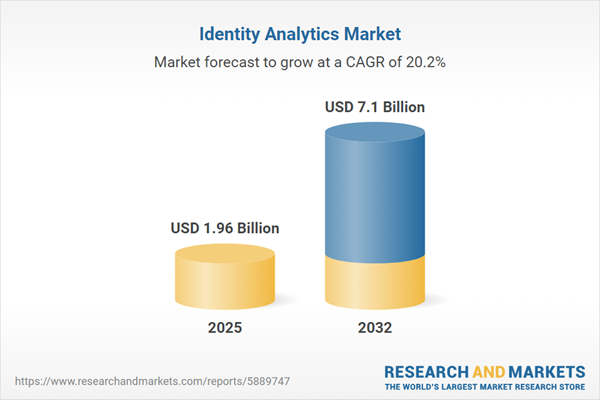Speak directly to the analyst to clarify any post sales queries you may have.
Identity analytics is shaping enterprise security, compliance, and risk management strategies, offering leaders a decisive edge in protecting assets and meeting evolving regulatory demands. As organizations increase their digital footprint, applying robust identity analytics becomes central to maintaining operational stability and confidence across industry segments.
Market Snapshot: Identity Analytics Market Size and Growth
The identity analytics market is experiencing sustained global growth, evidenced by rising adoption in finance, healthcare, retail, and other core sectors. Enterprises prioritize investments in adaptive authentication and analytics-led governance as a direct response to a challenging digital risk environment. Increased regulatory oversight is encouraging organizations to implement identity analytics solutions, supporting proactive identity and access management strategies. This proactive approach allows them to address compliance requirements and reinforce security frameworks even amidst rapidly changing market and technology conditions. Leading vendors continue advancing the sector by responding to these trends with ongoing product innovation and expanded capabilities.
Scope & Segmentation of the Identity Analytics Market
- Product Types: Hardware platforms establish secure environments for credential storage, while software platforms analyze user behaviors and surface actionable risk insights. Professional services are integral to effective implementation and integration within diverse business structures, maximizing efficiency and return on investment.
- Deployment Models: Organizations can select from public cloud, private cloud, multi-cloud, on-premises, and hybrid options, aligning analytics deployment with their own regulatory, operational, and data sovereignty needs.
- End User Industries: Banking, insurance, telecom, healthcare, manufacturing, IT, and retail use identity analytics to address unique sectoral threats and comply with industry-specific regulatory standards.
- Organization Sizes: Large enterprises benefit from centralized analytics to strengthen governance, while smaller organizations implement modular solutions for scalable security and compliance as their operational exposure grows.
- Sales Channels: Direct sales, system integrators, value-added resellers, and distributors provide targeted procurement routes to address varying technical demands and in-house IT capabilities.
- Technologies: Artificial intelligence—encompassing machine learning, computer vision, and natural language processing—accelerates detection and response. Integration with big data infrastructures and cloud-native platforms, including IaaS, PaaS, SaaS, and IoT, supports effective risk management across distributed networks.
- Geographic Coverage: Solutions are tailored to regulatory environments in the Americas, Europe, Middle East, Africa, and Asia-Pacific, adapting to established and developing markets with customized compliance controls.
- Key Companies: Vendors such as Microsoft Corporation, IBM, Oracle, SAP SE, Okta, Ping Identity Holding Corp., SailPoint Technologies, CyberArk Software, ForgeRock, and Saviynt offer scalable identity analytics platforms that evolve with compliance and risk management requirements.
Key Takeaways for Senior Decision-Makers
- Identity analytics empowers organizations to establish precise, dynamic access controls and strengthen operational monitoring, driving early identification and mitigation of potential threats.
- Continuous analytics, along with zero trust models, advance organizational security by detecting unusual activities and extending risk protection beyond traditional access controls.
- Flexible identity management platforms enable swift adaptation to shifting privacy and compliance requirements, minimizing operational, regulatory, and reputational risks.
- Real-time monitoring directs resource allocation to the most vulnerable points in enterprise operations, refining return on security investment and risk response.
- Strategic partnerships with technology providers, integrators, and local experts support resilient compliance postures and help organizations adjust to evolving regulatory landscapes.
- AI-driven analytics solutions facilitate streamlined audit readiness and enhance compliance accuracy, delivering particular value to enterprises in highly regulated sectors.
Tariff Impact: Adaptation in Supply Chain and Deployment
New tariffs affecting technology hardware are impacting procurement and supply chain strategies within the identity analytics sector. Enterprises are transitioning toward cloud-based identity analytics to mitigate hardware cost pressures and maximize operational agility. In response, solution vendors are updating licensing models and embedding advanced compliance features in their cloud portfolios. The wider shift to nearshore and locally managed data centers is fortifying supply chains, helping companies address changing requirements for data protection, compliance, and regulation amid new international trade conditions.
Methodology & Data Sources
This market analysis draws on executive interviews, technical briefings, and structured industry surveys, offering a comprehensive view of identity analytics adoption. Insights are validated through regulatory filings, authoritative white papers, and leading peer-reviewed research publications for reliability.
Why This Report Matters
- Offers concise, actionable guidance for C-level leaders seeking to optimize identity analytics strategies, improving security and governance across the enterprise.
- Delivers clear, data-driven insights on technology adoption, vendor capabilities, and emerging market practices to inform operational and compliance decisions.
- Enables organizations to stay agile in the face of ongoing supply chain disruptions and shifting regulatory demands, ultimately strengthening enterprise resilience.
Conclusion
Robust identity analytics supports secure digital transformation and improved compliance confidence for senior executives. Applying the insights from this report enables organizations to enhance risk management and maintain effective governance as they evolve.
Additional Product Information:
- Purchase of this report includes 1 year online access with quarterly updates.
- This report can be updated on request. Please contact our Customer Experience team using the Ask a Question widget on our website.
Table of Contents
3. Executive Summary
4. Market Overview
7. Cumulative Impact of Artificial Intelligence 2025
Companies Mentioned
The companies profiled in this Identity Analytics market report include:- Microsoft Corporation
- International Business Machines Corporation
- Oracle Corporation
- SAP SE
- Okta, Inc.
- Ping Identity Holding Corp.
- SailPoint Technologies Holdings, Inc.
- CyberArk Software Ltd.
- ForgeRock, Inc.
- Saviynt Inc.
Table Information
| Report Attribute | Details |
|---|---|
| No. of Pages | 197 |
| Published | October 2025 |
| Forecast Period | 2025 - 2032 |
| Estimated Market Value ( USD | $ 1.96 Billion |
| Forecasted Market Value ( USD | $ 7.1 Billion |
| Compound Annual Growth Rate | 20.2% |
| Regions Covered | Global |
| No. of Companies Mentioned | 11 |









